Yamaha MusicCast BAR 40 Review
Yamaha MusicCast BAR 40 Review
A solid 2-channel soundbar that delivers a great performance with movies and music
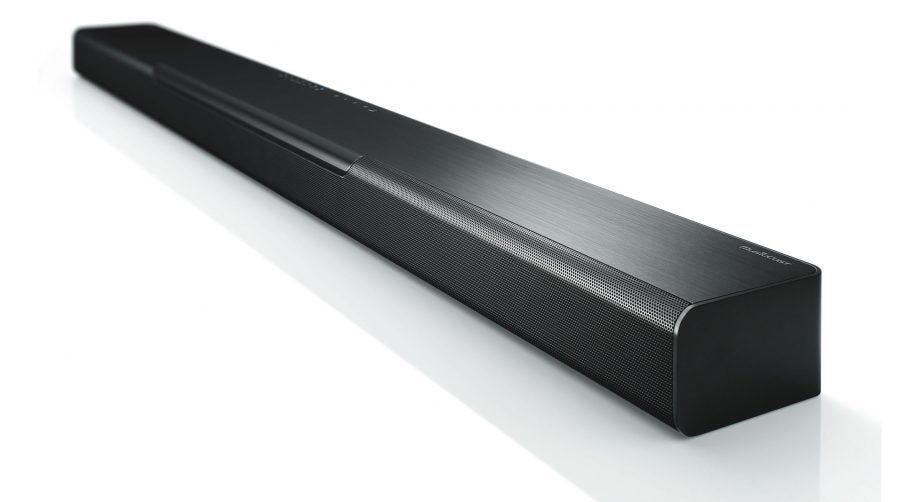
Verdict
A solid two-channel soundbar with multiroom capabilities and upgrade options, but it lacks real bass
Pros
- Good with movies and music
- MusicCast multiroom support
- Attractive and well made
- Upgrade options
- Easy setup
Cons
- No Dolby Atmos/DTS:X
- No separate subwoofer
- Only one HDMI input
Key Specifications
- Review Price: £329
- 2-channel soundbar
- DTS Virtual:X
- MusicCast
- Dimensions: 98cm x 6cm x 11cm
- 100W total power output
- 2 x HDMI, 1 x optical, 1 x analogue
What is the Yamaha MusicCast BAR 40?
The Yamaha MusicCast BAR 40 is an entry-level two-channel soundbar; it’s also referred to as the YMS-4080.
It’s essentially the same as the BAR 400 but without a dedicated wireless subwoofer, instead providing the option of adding the SUB100. As with the BAR 400, you can also create a 4.1-channel system by adding a pair of MusicCast 20 or 50 wireless speakers.
Not surprisingly given the name, the BAR 40 includes Yamaha’s MusicCast multiroom technology. It also supports Hi-Res Audio, and offers a number of music streaming services built in. In terms of connections you get multiple HDMI ports, Bluetooth, and Apple AirPlay, along with voice control via Amazon Alexa and DTS Virtual: X for a more immersive audio experience.
Thanks to a recent price drop you can pick up the Yamaha MusicCast BAR 40 for less than £300, but how does it compare to the competition – and would you be better off simply paying £459 for the 2.1-channel MusicCast BAR 400?
Related: Best soundbars
Yamaha MusicCast BAR 40 – Design and connections
The Yamaha MusicCast BAR 40 is almost identical to the soundbar included in the more expensive BAR 400 package, which means it comes in black and offers the same excellent build quality. It also sports a curved leading edge with a metal grille, and a brushed metal finish along the top. At the rear are screw holes for those who want to wall mount the unit.
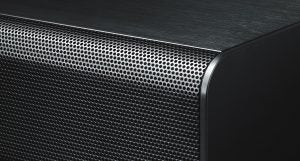
The soundbar has two front-firing speakers, each of which includes a pair of 4.6cm woofers and a 2.5cm tweeter. There are 50W of built-in amplification for each speaker, so the BAR 40 has plenty of power. It’s also discreet, with a low form factor and a height of only 6cm, so it shouldn’t block the screen if placed in front of your TV.
A group of small lights on the top panel are the only form of display, registering which input you’ve selected: HDMI, ARC, Analogue, and Bluetooth/Net. Additional indicators show which surround mode is selected, and any Wi-Fi or Bluetooth connection. There’s also a series of basic touch-sensitive controls for source select, mute, volume up/down, and power/connect.
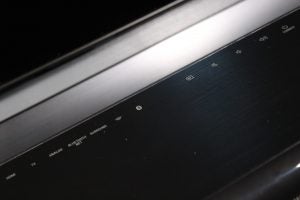
The BAR 40 has the same diminutive remote included with the BAR 400, but it includes all you need to effectively set up and operate the soundbar. There’s also the option to control the BAR 40 using the excellent MusicCast app, which is probably the best approach since the user interface on the app makes up for the lack of any meaningful display on the soundbar.
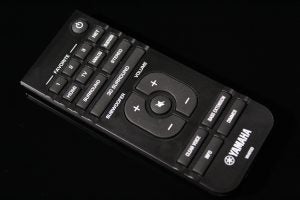
All the connections are in a recessed area on the underside of the soundbar, and here you’ll find an HDMI input and an output that supports ARC (Audio Return Channel). All the HDMI ports support 4K at 50/60p, HDCP 2.2, and High Dynamic Range (HDR10, Dolby Vision, and Hybrid Log Gamma).
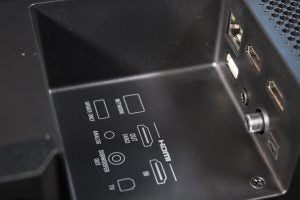
There’s also an optical digital audio input, a 3.5mm analogue audio input, a subwoofer out (this is missing on the BAR 400 because it comes with a wireless sub) and an Ethernet port for a wired connection. On the wireless side there’s built-in Wi-Fi (2.4/5GHz) for use with MusicCast, although if you don’t want to use the latter then there’s also Bluetooth (Ver. 4.2+EDR/A2DP, AVRCP) and Apple AirPlay.
Related: What is HDR?
Yamaha MusicCast BAR 40 – Features
The Yamaha MusicCast BAR 40 supports a host of surround formats including lossy Dolby Digital, Dolby Pro Logic II, and DTS Digital Surround. However, it doesn’t support lossless Dolby TrueHD or DTS-HD Master Audio, so there’s no object-based formats such as Dolby Atmos and DTS:X.
Instead it includes DTS Virtual:X, which uses psychoacoustic processing to create a more immersive experience from a two-channel source. There’s also the Clear Voice feature, which boosts the clarity of dialogue in TV shows and movies.
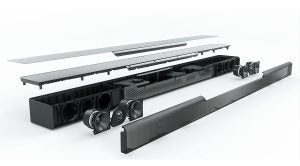
You can control the BAR 40 using your voice thanks to compatibility with Amazon Alexa. Setup is fairly straightforward, but you need to be specific in terms of your commands. As such, you might find it’s easier to simply reach for the remote.
MusicCast is Yamaha’s multiroom technology, and is now built into most of its products. It allows you to seamlessly stream music from one MusicCast product to another, all controlled via a dedicated app that’s well designed and intuitive.
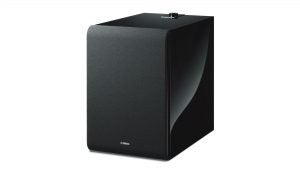
There are a number of streaming services built into the app including Spotify, Deezer, Tidal, and Qobuz, along with support for High-Resolution Audio up to 24bit/192kHz using MP3, WAV, AAC, AIFF, WMA, Apple Lossless, and FLAC file types.

Yamaha offers the SUB 100 wireless subwoofer as an optional add-on for those who want to beef up the bass, and thanks to MusicCast you also have the ability to add wireless surrounds, using either the MusicCast 20 or 50 speakers, to create a 4.1-channel system.
Yamaha MusicCast BAR 40 – Performance
The Yamaha MusicCast BAR 40 delivers a solid all-round performance that makes it ideal for watching both TV shows and movies, as well as listening to music. It boasts a wide frequency range, and is capable of rendering plenty of top-end detail.
It can deliver a big front soundstage, making it ideal for TVs with screen sizes up to 65 inches. It has plenty of power under the hood too, enabling it to kick out a decent volume without becoming strained or distorted. It can easily fill a modestly sized living room.
Related: Best soundbar deals
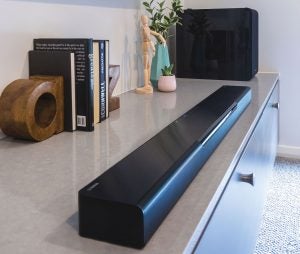
The overall performance is reasonably accomplished, and certainly a step up from the speakers built into your TV. The BAR 40 displays good dynamic range, allowing the soundbar to deliver music and effects with clarity and depth. Despite the lack of a dedicated centre speaker, dialogue remains clear and focused on the screen. If you feel it needs emphasising, the Clear Voice feature is quite useful for boosting any programme where speech is the main component.
The main area of weakness is the limited bass. As a result, movies in particular lack the full impact you’d get from a soundbar paired with a separate subwoofer. However, if deep bass is important to you then there is the option to add the SUB 100 wireless sub or any wired version using the sub-out on the soundbar.
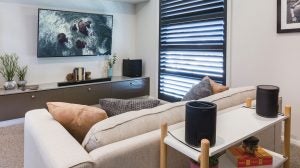
If you’re watching regular TV programmes then the BAR 40 can reproduce the sounds with precision and clarity – whether it’s the voiceover and music on Masterchef, or the commentary and crowd noises during a football match.
If you switch to a movie such as Avengers: Infinity War, there’s a good front soundstage with plenty of width and some effective depth. The lack of bass is more obvious, but the DTS Virtual:X processing is quite effective at adding more dimensionality to the audio.
The two-channel nature of the BAR 40 makes it great for listening to music. It’s an area where this model is particularly strong, especially with the inclusion of MusicCast and support for Hi-Res Audio. The Yamaha delivers a surprisingly nuanced performance for a soundbar and, regardless of genre, it’s capable of rendering the music with some skill.
Related: What is Hi-Res Audio?
Why buy the Yamaha MusicCast BAR 40?
The Yamaha MusicCast BAR 40 is a highly competent soundbar from a company that’s dominated this particular segment of the audio market for years. It’s a well made unit that can deliver a decent two-channel performance, and thanks to the inclusion of DTS Virtual:X it can even create a degree of immersion.
There’s no support for genuine immersive formats such as Dolby Atmos, but the inclusion of Yamaha’s MusicCast multiroom system is a definite plus point. There are also other useful features such as Clear Voice, Hi-Res Audio, and compatibility with Amazon Alexa. The bass lacks punch but there’s an optional wireless subwoofer, and even the ability to run a full 4.1 system using MusicCast.
If you’re looking for alternatives, the Wharfedale Vista 200S is definitely worth considering. This 2.1-channel system doesn’t boast many features but if you can find another high-quality soundbar and wireless sub combination for less than £219 then we’d like to hear about it.
If you like the idea of the BAR 40 but want a wireless subwoofer included, the obvious choice is the Yamaha MusicCast BAR 400. This is exactly the same soundbar and offers all the same features, but it comes with a wireless sub included for £459.
Verdict
This solid 2-channel soundbar includes MusicCast multiroom capabilities and upgrade options, but despite the inclusion of DTS Virtual:X, there’s no support for immersive audio.


